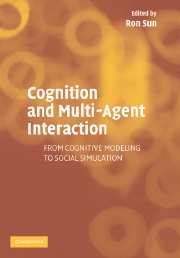Book contents
- Frontmatter
- Contents
- List of Contributors
- Preface
- PART 1 INTRODUCTION
- PART 2 OVERVIEWS OF COGNITIVE ARCHITECTURES
- 2 Modeling Paradigms in ACT-R
- 3 Considering Soar As An Agent Architecture
- 4 The CLARION Cognitive Architecture: Extending Cognitive Modeling to Social Simulation
- PART 3 MODELING AND SIMULATING COGNITIVE AND SOCIAL PROCESSES
- PART 4 A SYMPOSIUM
- Index
4 - The CLARION Cognitive Architecture: Extending Cognitive Modeling to Social Simulation
Published online by Cambridge University Press: 15 December 2009
- Frontmatter
- Contents
- List of Contributors
- Preface
- PART 1 INTRODUCTION
- PART 2 OVERVIEWS OF COGNITIVE ARCHITECTURES
- 2 Modeling Paradigms in ACT-R
- 3 Considering Soar As An Agent Architecture
- 4 The CLARION Cognitive Architecture: Extending Cognitive Modeling to Social Simulation
- PART 3 MODELING AND SIMULATING COGNITIVE AND SOCIAL PROCESSES
- PART 4 A SYMPOSIUM
- Index
Summary
INTRODUCTION
This chapter presents an overview of a relatively recent cognitive architecture for modeling cognitive processes of individual cognitive agents (in a psychological sense) (see Sun et al., 1998, 2001; Sun, 2002). We will start with a look at some general ideas underlying this cognitive architecture as well as the relevance of these ideas to social simulation.
To tackle a host of issues arising from computational cognitive modeling that are not adequately addressed by many other existent cognitive architectures, such as the implicit-explicit interaction, the cognitivemetacognitive interaction, and the cognitive-motivational interaction, CLARION, a modularly structured cognitive architecture, has been developed (Sun, 2002; Sun et al., 1998, 2001). Overall, CLARION is an integrative model. It consists of a number of functional subsystems (for example, the action-centered subsystem, the metacognitive subsystem, and the motivational subsystem). It also has a dual representational structure – implicit and explicit representations being in two separate components in each subsystem. Thus far, CLARION has been successful in capturing a variety of cognitive processes in a variety of task domains based on this division of modules (Sun et al., 2002). See Figure 4.1 for a sketch of the architecture.
A key assumption of CLARION, which has been argued for amply before (see Sun et al., 1998, 2001; Sun, 2002), is the dichotomy of implicit and explicit cognition. Generally speaking, implicit processes are less accessible and more “holistic,” whereas explicit processes are more accessiblee crisp (Reber, 1989; Sun, 2002). This dichotomy is closely related to some other well-known dichotomies in cognitive science: the dichotomy of symbolic versus subsymbolic processing, the dichotomy of conceptual versus subconceptual processing, and so on (Smolensky, 1988; Sun, 1994).
- Type
- Chapter
- Information
- Cognition and Multi-Agent InteractionFrom Cognitive Modeling to Social Simulation, pp. 79 - 100Publisher: Cambridge University PressPrint publication year: 2005
- 35
- Cited by



